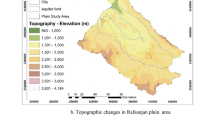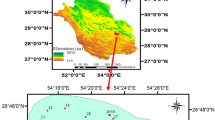Abstract
The continuous growth and development of population need more fresh water for drinking, irrigation, and domestic in arid countries like Egypt. Evaluation the quality of groundwater is an essential study to ensure its suitability for different purposes. In this study, 812 groundwater samples were taken within the middle area of Upper Egypt (Sohag Governorate) to assess the quality of groundwater for drinking and irrigation purposes. Eleven water parameters were analyzed at each groundwater sample (Na+, K+, Ca2+, Mg2+, HCO3 − SO4 2−, Fe2+, Mn2+, Cl−, electrical conductivity, and pH) to exploit them in water quality evaluation. A classical statistics were applied for the raw data to examine the distribution of physicochemical parameters in the investigated area. The relationship between groundwater parameters was tested using the correlation coefficient where a strong relationship was found between several water parameters such as Ca2+ and Cl−. Water quality index (WQI) is a mathematical model used to transform many water parameters into a single indicator value which represents the water quality level. Results of WQI showed that 20% of groundwater samples are excellent, 75% are good for drinking, and 7% are very poor water while only 1% of samples are unsuitable for drinking. To test the suitability of groundwater for irrigation, three indices are used; they are sodium adsorption ration (SAR), sodium percentage (Na%), and permeability index (PI). For irrigation suitability, the study proved that most sampling sites are suitable while less than 3% are unsuitable for irrigation. The spatial distribution of the estimated values of WQI, SAR, Na%, PI, and each groundwater parameter was spatially modeled using GIS.





Similar content being viewed by others
References
Ahmed AA, Ali MH (2011) Hydrochemical evolution and variation of groundwater and its environmental impact at Sohag. Egypt Arabian Journal of Geosciences 4:339–352. doi:10.1007/s12517-009-0055-z
Ahmed AA (2009) Using lithologic modeling techniques for aquifer characterization and groundwater flow modeling of the Sohag area. Egypt Hydrogeology Journal 17:1189–1201. doi:10.1007/s10040-009-0461-z
Ahmed AA (2007) Using contamination and pesticide DRASTIC GIS-based models for vulnerability assessment of Quaternary aquifer at Sohag, Egypt. In: The 5th Intern. Conf Geol Africa (1), pp 29–47
Akter T et al (2016) Water quality index for measuring drinking water quality in rural Bangladesh: a cross-sectional study. J Health Popul Nutr 35:4–4. doi:10.1186/s41043-016-0041-5
Aly AA, Al-Omran AM, Alharby MM (2015) The water quality index and hydrochemical characterization of groundwater resources in Hafar Albatin. Saudi Arabia Arabian Journal of Geosciences 8:4177–4190
Ahramonline J (2016) 3/4 of Egyptian villages lack sewage systems: CAPMAS. http://english.ahram.org.eg/NewsContent/1/64/177602/Egypt/Politics-/-of-Egyptian-villages-lack-sewage-systems-CAPMAS.aspx
Awad MA, Nada AA, Hamza MS, Froehlich K (1995) Chemical and isotopic investigation of groundwater in Tahta region. Sohag-Egypt Environmental Geochemistry and Health 17:147–153. doi:10.1007/bf00126083
Ayers RS, Westcot DW (1985) Water quality for agriculture vol 29. Food and Agriculture Organization of the United Nations Rome
Boateng TK, Opoku F, Acquaah SO, Akoto O (2016) Groundwater quality assessment using statistical approach and water quality index in Ejisu-Juaben Municipality. Ghana Environmental Earth Sciences 75:1–14. doi:10.1007/s12665-015-5105-0
El Arabi N (2012) Environmental management of groundwater in Egypt via artificial recharge extending the practice to soil aquifer treatment (SAT) vol 1. 2012, vol 3.
El-Haddad A, El-Shater A (1988) Sediments characteristics as a controlling factor of pollution of the groundwater from disposed of wastes, Sohag, Egypt. Sohag Pure & Appl Sci Bull Fac Sci 4:145–162
Farrag Ah (2005) The hydraulic and hydrochemical impacts of the nile system on the groundwater in Upper Egypt vol 8, March 2005 edn. Ass. Univ. Bull. Environ. Res., Ass. Univ
Gebrehiwot AB, Tadesse N, Jigar E (2011) Application of water quality index to assess suitability of groundwater quality for drinking purposes in Hantebet watershed. Tigray, Northern Ethiopia ISABB Journal of Food and Agriculture Science 1:22–30
Hassan HA, Rasheedy AA (2007) The Nile River and Egyptian Foreign Policy Interest African Sociological Review/Revue Africaine de Sociologie 11
Ibrahim M, Ali M, Kotb M (2010) Soil properties as affected by different land management practices in the Sohag Region. South Egypt New York Science Journal 3:8–19
Johnston K, Ver Hoef JM, Krivoruchko K, Lucas N (2001) Using ArcGIS geostatistical analyst vol 380. Esri Redlands
Kumar M, Kumari K, Ramanathan A, Saxena R (2007) A comparative evaluation of groundwater suitability for irrigation and drinking purposes in two intensively cultivated districts of Punjab. India Environmental Geology 53:553–574. doi:10.1007/s00254-007-0672-3
MaCalister C, Ie PP, Tindimugaya C, Ayenew T, Ibrahim ME, Meguid MA (2012) Overview of groundwater in the Nile river basin
Melegy AA, Shaban AM, Hassaan MM, Salman SA (2014) Geochemical mobilization of some heavy metals in water resources and their impact on human health in Sohag Governorate. Egypt Arabian Journal of Geosciences 7:4541–4552. doi:10.1007/s12517-013-1095-y
Mulat AG, Moges SA (2014) Assessment of the impact of the Grand Ethiopian Renaissance Dam on the performance of the High Aswan Dam Journal of Water Resource and Protection 2014
Organization WH (2004) Manganese in drinking-water: Background document for development of WHO Guidelines for Drinking-water Quality
Organization WH (2011) Guidelines for drinking-water quality. World Health Organization, Geneva
Rajankar PN, Tambekar DH, Wate SR (2010) Groundwater quality and water quality index at Bhandara District. Environ Monit Assess 179:619–625. doi:10.1007/s10661-010-1767-y
Ramakrishnaiah C, Sadashivaiah C, Ranganna G (2009) Assessment of water quality index for the groundwater in Tumkur Taluk. Karnataka State, India Journal of Chemistry 6:523–530
Ravikumar P, Aneesul Mehmood M, Somashekar RK (2013) Water quality index to determine the surface water quality of Sankey tank and Mallathahalli lake, Bangalore urban district, Karnataka, India. Appl Water Sci 3:247–261. doi:10.1007/s13201-013-0077-2
Sadat-Noori SM, Ebrahimi K, Liaghat AM (2014) Groundwater quality assessment using the Water Quality Index and GIS in Saveh-Nobaran aquifer, Iran. Environ. Earth Sci. 71(9):3827–3843. doi:10.1007/s12665-013-2770-8
Shabbir R, Ahmad SS (2015) Use of geographic information system and water quality index to assess groundwater quality in Rawalpindi and Islamabad Arabian. Journal for Science and Engineering 40:2033–2047. doi:10.1007/s13369-015-1697-7
Singh AK, Mondal G, Kumar S, Singh T, Tewary B, Sinha A (2008) Major ion chemistry, weathering processes and water quality assessment in upper catchment of Damodar River basin. India Environmental geology 54:745–758
Singh P, Khan I (2011) Ground water quality assessment of Dhankawadi ward of Pune by using GIS. International Journal of Geomatics and Geosciences 2:688–703
Srinivas P, Pradeep Kumar G, Srinivatas Prasad A, Hemalatha T (2011) Generation of groundwater quality index map—a case study. Civil and Environmental Research 1:9–21
Subramani T, Elango L, Damodarasamy SR (2005) Groundwater quality and its suitability for drinking and agricultural use in Chithar River Basin, Tamil Nadu, India. Environ Geol 47:1099–1110. doi:10.1007/s00254-005-1243-0
Sumathi VR, Natesan U, Sarkar C (2008) GIS-based approach for optimized siting of municipal solid waste landfill Waste Management 28:2146–2160 doi:http://dx.doi.org/10.1016/j.wasman.2007.09.032
Tahlawi ME, Mohamed M, Boghdadi G, Rabeiy R, Saleem H (2014) Groundwater quality assessment to estimate its suitability for different uses in Assiut Governorate, Egypt https://www.researchgate.net/publication/305688706
Trivedi P, Bajpai A, Thareja S (2009) Evaluation of water quality: physico–chemical characteristics of Ganga River at Kanpur by using correlation study. Nature and Science 1:91–94
Vasanthavigar M et al (2010) Application of water quality index for groundwater quality assessment: Thirumanimuttar sub-basin, Tamilnadu, India. Environ Monit Assess 171:595–609
Vasudevan S, Lakshmi J, Sozhan G (2009) Studies on the removal of iron from drinking water by electrocoagulation–A clean process. CLEAN–Soil, Air, Water 37(1):45–51
Walaa E (2014) Groundwater management in Egypt vol 11, Jul-Aug. 2014 edn. Journal of Mechanical and Civil Engineering
Wilcox LV (1955) Classification and use of irrigation waters vol November. US Department of Agriculture, Washington, DC
Youssef AM, Omer AA, Ibrahim MS, Ali MH, Cawlfield JD (2011) Geotechnical investigation of sewage wastewater disposal sites and use of GIS land use maps to assess environmental hazards: Sohag, Upper Egypt. Arab J Geosci 4:719–733. doi:10.1007/s12517-009-0069-6
Acknowledgments
The author thanks the Groundwater Sector (GWS) of Upper Egypt (belonging to Ministry of Water Resources and Irrigation). It provides this work with the data of groundwater samples and locations of each sample. I am greatly appreciating the help of Eng. Essam Hamdan (working at GWS, Upper Egypt) for his help in administrating the information of the supplied data.
Author information
Authors and Affiliations
Corresponding author
Additional information
Responsible editor: Philippe Garrigues
Rights and permissions
About this article
Cite this article
Rabeiy, R.E. Assessment and modeling of groundwater quality using WQI and GIS in Upper Egypt area. Environ Sci Pollut Res 25, 30808–30817 (2018). https://doi.org/10.1007/s11356-017-8617-1
Received:
Accepted:
Published:
Issue Date:
DOI: https://doi.org/10.1007/s11356-017-8617-1




